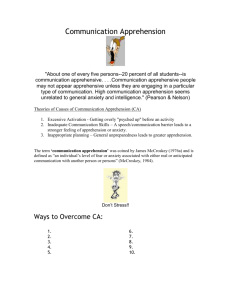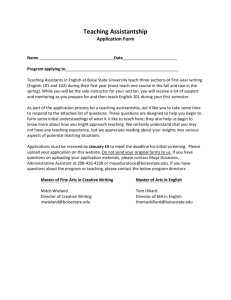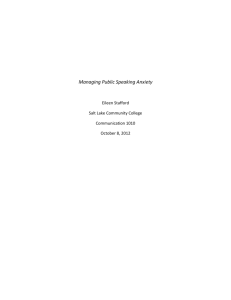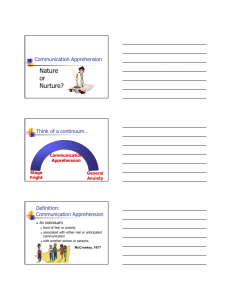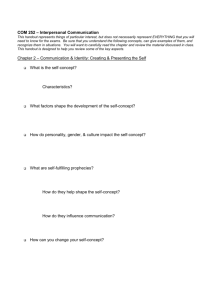View PDF - GEIST SCIENCE
advertisement
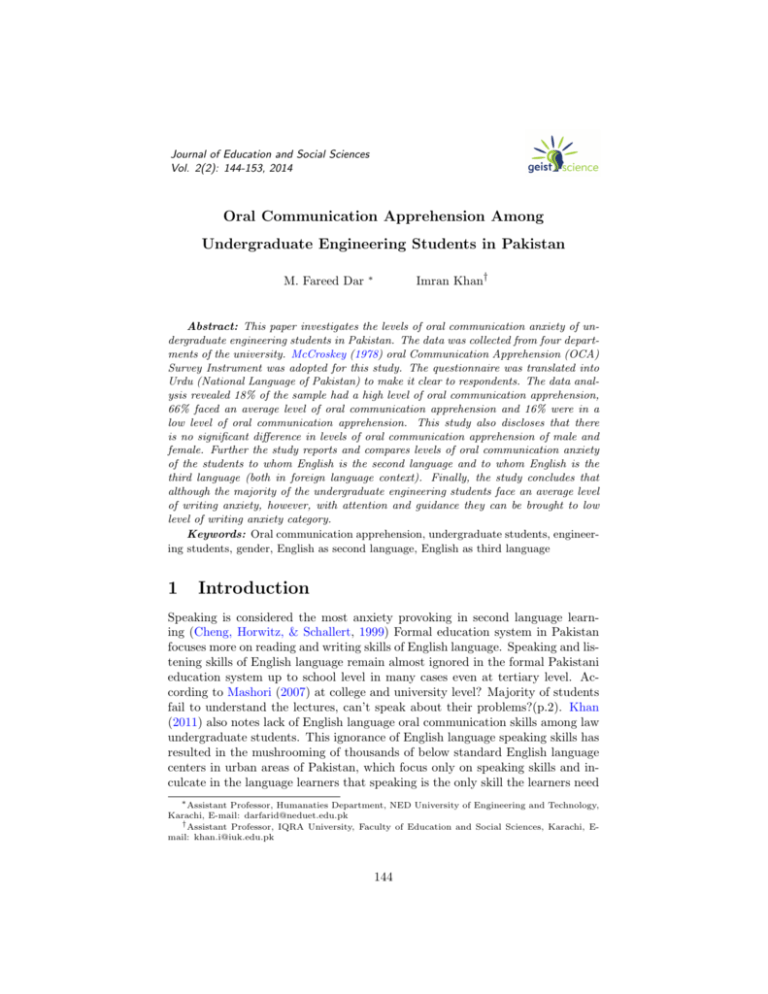
Journal of Education and Social Sciences Vol. 2(2): 144-153, 2014 Oral Communication Apprehension Among Undergraduate Engineering Students in Pakistan M. Fareed Dar Imran Khan† ∗ Abstract: This paper investigates the levels of oral communication anxiety of undergraduate engineering students in Pakistan. The data was collected from four departments of the university. McCroskey (1978) oral Communication Apprehension (OCA) Survey Instrument was adopted for this study. The questionnaire was translated into Urdu (National Language of Pakistan) to make it clear to respondents. The data analysis revealed 18% of the sample had a high level of oral communication apprehension, 66% faced an average level of oral communication apprehension and 16% were in a low level of oral communication apprehension. This study also discloses that there is no significant difference in levels of oral communication apprehension of male and female. Further the study reports and compares levels of oral communication anxiety of the students to whom English is the second language and to whom English is the third language (both in foreign language context). Finally, the study concludes that although the majority of the undergraduate engineering students face an average level of writing anxiety, however, with attention and guidance they can be brought to low level of writing anxiety category. Keywords: Oral communication apprehension, undergraduate students, engineering students, gender, English as second language, English as third language 1 Introduction Speaking is considered the most anxiety provoking in second language learning (Cheng, Horwitz, & Schallert, 1999) Formal education system in Pakistan focuses more on reading and writing skills of English language. Speaking and listening skills of English language remain almost ignored in the formal Pakistani education system up to school level in many cases even at tertiary level. According to Mashori (2007) at college and university level? Majority of students fail to understand the lectures, can’t speak about their problems?(p.2). Khan (2011) also notes lack of English language oral communication skills among law undergraduate students. This ignorance of English language speaking skills has resulted in the mushrooming of thousands of below standard English language centers in urban areas of Pakistan, which focus only on speaking skills and inculcate in the language learners that speaking is the only skill the learners need ∗ Assistant Professor, Humanaties Department, NED University of Engineering and Technology, Karachi, E-mail: darfarid@neduet.edu.pk † Assistant Professor, IQRA University, Faculty of Education and Social Sciences, Karachi, Email: khan.i@iuk.edu.pk 144 Journal of Education and Social Sciences to focus. 2 Review of Related Literature Rachman (2004) defines anxiety “Anxiety is the tense, unsettling anticipation of a threatening but a vague event; a feeling of uneasy suspense. It is a negative affect so closely related to fear.” According to Oxford language anxiety is “fear or apprehension occurring when a learner is expected to perform in the second or foreign language.” (p.59) (As cited in Macros-Linas and Garau, 2009). McCroskey (1978) coined this term “Oral Communication Apprehension” (OCA). Since then there has been much research on OCA in first language, second language and foreign language contexts. In Mckroskey’s words OCA is an ?individual’s level of fear or anxiety associated with either real or anticipated communication with another person or persons” (McCroskey, 1977). Simons, Higgins and Lowe, (1995) define Oral Communication Apprehension as, “Oral communication apprehension (OCA) is a fear of having verbally communicating with people.” (p. 160) (As cited in Marcos-Llinás and Garau (2009)) Oral communication apprehension is a very common phenomenon in foreign/second language context (Rashidi, Yamini, & Shafiei, 2011). Awan, Azher, Anwar, Naz, et al. (2010) also state that speaking in front of others is most anxiety provoking for non-native English language speakers. In oral communication public speaking is the most anxiety provoking. Speaking in public is a widely known fear, for decades, it has received attention of communication scholars (Witt & Behnke, 2006). “Public speaking anxiety is a common social phobia” (Docan-Morgan & Schmidt, 2012). In some public speakers, public speaking anxiety resembles permanent trait, in others it closely resembles to temporary state in many others, it is situation specific (Witt & Behnke, 2006). Studies have also reported different levels of oral communication apprehension (OCA) for male and female. Female are significantly more oral communication apprehensive than male (McKroskey) as cited in (Simons, Higgins, & Lowe, 1995). Tianjian (2010) reports an insignificant difference of speaking anxiety between male and female. Many researches have explored reasons of OCA. Villar (2010) finds out eight reasons of oral communication anxiety given by beginning Filipino students. The eight factors are “expectations, training and experience, audience, selfworth, rejection, verbal fluency, preparation and previous unpleasant experience”(p.167). McCroskey (1976) notes that those students who have moderate communication apprehension at the preschool level, negative reinforcement of their peer and teacher can make them high apprehensive. (Subasi, 2010) proves empirically that the fear of negative evaluation and self-perception of speaking ability in the target language are potential sources of anxiety for Turkish learners of English. (Tsiplakides & Keramida, 2009) explorer causes of writing anxiety as: low self-perception about speaking, fear of negative evaluation from peers, fear of mistakes, high anxious students’ comparison of speaking abilities with peers. 145 Journal of Education and Social Sciences Statement of the Problem English language oral communication skills are important for employment and higher studies in Pakistan (Dar, Zaki, & Kazmi, 2010). Employment interviews for graduates are in English language or most part of the interviews at the level is in English language. Similarly, the formal oral presentation and meetings in middle and higher management are also in English language. The importance of oral communication skills increases in multinational organization. At tertiary level speaking skills are given some importance. Many universities and institutions even offer oral communication courses at undergraduate level. Students at undergraduate and graduate level are also required to give oral presentations in English language in most of the subjects. In Engineering, more focus is given to the field related subjects and communication - skills are not given much attention ? particularly oral communication skills. Pakistani employers appreciate engineers? fields? related knowledge and skills to some extent, but are not satisfied with the communication skills of the undergraduate engineers. Lack of communication skills among engineers is not only a local issue in Pakistan, it has also been reported in other countries. Devi and Feroz (2008) refer to The Boyer Commission (2003) which reports that faculty, administrators and potential employers are concerned about the graduates’ lack of oral communication skills. (Devi & Feroz, 2008) rightly point out the need for engineering universities to meet the industry need and produce engineers who have communication competence. Oral communication anxiety can be one of the reasons of engineers’ low level of oral communication skills. To the best of the researcher’s knowledge, no study in Pakistan has been carried out to measure levels of undergraduate engineers’ oral communication anxiety. The purpose of this study was to measure levels of Oral Communication Apprehension (OCA) of undergraduate Engineering students in Pakistan. This study further investigates levels of oral communication apprehension for both genders and for those to whom English is a second language and third language in foreign language context. Research Questions 1. What are levels of oral communication apprehension among undergraduate engineering students? 2. Does the oral communication anxiety they experience differ for gender and for those to who English is second language and to whom English is third language (both in foreign language context)? 3 Methodology and Sampling Technique The study adopts a quantitative approach. Twenty one departments of a public sector engineering university in Karachi were taken as a target population of this study. The sample of this study consisted of four departments at the 146 Journal of Education and Social Sciences university. Data for this study was collected from 2nd, 4th and 6th semester students of Bachelors of Engineering (BE) Program. Data for this study was collected through convenient sampling technique. McCroskey (1978) Oral Communication Apprehension (OCA) Survey Instrument with its Urdu translation was given to 400 undergraduate engineering students in fall 2012. 56 questionnaires were either not returned or partially filled which were not considered for this study, hence sample of the study were 334 undergraduate engineering students from the four departments of the university. The sample had a representation of both genders. The sample consisted of 29.3% (98) female and 70.7% (236) male. Ratio of male students in engineering studies in Pakistan is much greater than female as represented in the sample. McCroskey (1978) Oral Communication Apprehension (OCA) Survey Instrument was adopted for this study. OCA is a five-point Likert scale ranging from ‘strongly disagree’ to ‘strongly agree’ other three options are ‘disagree’, ‘agree’ and ‘undecided’. The questionnaire is composed of 25 statements concerning interpersonal oral communication. To facilitate participants and get true response the questionnaire was translated into Urdu (National Language of Pakistan) and the word ‘in English’ was included in parenthesis in some sentences both in English and Urdu translation to make the meaning clear to respondents. The reliability of the translation was judged by five experts. Quantitative data collected from McCroskey (1978) OCA were analyzed with the help of Statistical Package for Social Sciences (SPSS) ver. 22. 4 Findings The sample represents both genders, male and female: 70.7%, and 20.3% respectively. The ratio of female in higher education in engineering is lower than male, as it can be seen in the sample. Majority (78.7%) of the participants belong to age group of 20-23, the second largest number of participants in the sample is of age group under 20 is 19.8%. The remaining three age groups: 2427, 28-31 and others have very low representation: 0.9, 0.3 and 0.3 respectively. All of the participants were from the undergraduate engineering program. 91% of the participants were full time students; whereas 9% of the sample were part time student. The sample also represents all major races (based on language) in Pakistan. The study was conducted in Karachi hence maximum number of participants were Urdu Speaking 64.1% the second biggest representation was of Punjabi speaking 14.1%, others 8.7%, Sindhi speaking 6.3%, Pushtun 3.6%, Gujrati 2.1%, Saraiki 0.9%, and Baloch 0.3%. 147 Journal of Education and Social Sciences Table 1: Demographics of the participants Frequency Gender Male Female Total % 236 98 334 Age Group Under 20 66 20-23 263 24-27 3 28-31 1 Others 1 Total 334 Educational Program Undergraduate 334 Engineering Students Employment Status Full time student 304 Part time 30 student Total 334 Race/Ethnicity Punjabi 47 Pashtun 12 Sindhi 21 Saraiki 3 Urdu Speaking 214 Baloch 1 Gujrati 7 Others 29 Total 334 70.7 29.3 100 19.8 78.7 0.9 0.3 0.3 100 100 91 9 100 14.1 3.6 6.3 0.9 64.1 0.3 2.1 8.7 100 Table 2: Mean and standard deviation of the sample N 334 Mean 72.16 Std. Deviation 8.663 Participants whose score is equal to or more than mean score of the sample plus one standard deviation are high apprehensive students -80 or above. Participants who score equal to or less than mean score of the sample minus one standard deviation are low apprehensive students -64 or below. The remaining participants who score between low and high apprehensive range 65-79 are average apprehensive students. Table 3: Oral Communication Anxiety category and score range for each category Oral Communication Anxiety Category High Apprehensive Average Apprehensive Low Apprehensive 148 Score Range 80 or above 65 - 79 64 or below Journal of Education and Social Sciences Table 4: Participants’ levels of oral communication apprehension Categories High Apprehensive Average Apprehensive Low Apprehensive Total *rounded to closer whole N %* 60 18 221 66 53 16 334 100 number Majority of the students 221 (66%) have average level of oral communication apprehension. Sixty participants who become 18% of the sample have high level of oral communication apprehension. 53 participants that make 16% of the sample fall into low level of oral communication apprehension. Table 5: Male students’ levels of oral communication apprehension Categories High Apprehensive Average Apprehensive Low Apprehensive Total *rounded to closer whole N %* 44 19 156 66 36 15 236 100 number Table 6: Female students’ levels of oral communication apprehension Categories High Apprehensive Average Apprehensive Low Apprehensive Total N 16 65 17 98 % 16.33 66.33 17.34 100 19% of the male are high apprehensive, as compare to 16.33% of the female. The percentage of male and female students, in average apprehension category, is almost the same: for male 66% and for female 66.33%. Similarly, the difference of male and female students in low apprehensive category is also only of 2%: male 15% and female 17%. No significant difference, in the levels of oral communication apprehension between male and female, was notice in this study. Table 7: Levels of oral communication apprehension of students English is the second language (in foreign language context) Categories High Apprehensive Average Apprehensive Low Apprehensive Total N 43 143 28 214 % 20 67 13 100 As compared to the comparison of levels of oral communication anxiety between male and female the difference between those to whom English is the second language and to whom English is the third language (both in foreign language contexts) difference more. The percentage of high apprehensive for whom English is second language is 20% and for those for whom English is 149 Journal of Education and Social Sciences Table 8: Levels of oral communication apprehension of students English is third language (in foreign language context) Categories High Apprehensive Average Apprehensive Low Apprehensive Total N 17 78 25 120 % 14 65 21 100 third language is 14%. In average apprehensive category, the difference between the both is only of 2%. 67% of the students for whom English is the second language are in average apprehensive category and 65% of the students to whom English is the third language are in average level of OCA. In low apprehensive category percentage of students for whom English is the third language is eight percent more than those to whom English is the third language. 5 Discussion and Conclusion Majority of the total participants 66% faced average level of oral communication apprehension, 18% of them faced high level of oral communication apprehension and 16% of the students reported low level of oral communication apprehension.The difference in the levels of oral communication anxiety across gender is not significant. 2.67% of the male students are more high oral communication apprehensive than female, whereas 0.33% of the female are more in average oral communication apprehension and 2% female are more in low communication apprehension category. Percentage of high apprehensive participants for whom English is a second language is 6% more than those for whom English is a third language. In average apprehensive category 2% students for whom English is second language are more than those to whom English is third language. In low apprehensive category percentage of students for whom English is the third language is 8% more than those to whom English is the third language. Though majority of the undergraduate engineering students is average oral communication apprehensive, but at the same time, 18% of them are high apprehensive and only 16% are low oral communication apprehensive. The majority of the average communication apprehensive students can be taken to low average communication apprehension category if they are provided proper guidance and counseling. They can go to the high level of oral communication apprehension if proper attention is not given. The male and female difference in oral communication anxiety is not significant; hence both genders should be given equal chances and attention in oral communication. Though in a class of seventy students usually it is very difficult to detect the students to whom English is second language and the ones to whom English is third language. As the majority of the undergraduate students, 66% face average level of oral communication anxiety efforts should be made to reduce their writing anxiety level to low anxiety level, regardless of the fact, that either English is second or third language to them. Because, inquiring about learners’ first language in 150 Journal of Education and Social Sciences class can create problems. The students may feel the teacher wants to know their ethnicity to penalize or favor them, at the same time presence of political practices in universities/colleges/institutes can also give it a political color. The difference as shown in the result that those to whom English is third language are less oral communication apprehensive than those to whom English is second language (both in foreign language context), may be due to schooling system the participants have come from, because in Pakistan we have many standards for schooling such as elite schools non-elite schools and many further categories in elite schools and even dozens of categories in non-elite schools. 151 Journal of Education and Social Sciences References Awan, R.-u.-N., Azher, M., Anwar, M. N., Naz, A., et al. (2010). An investigation of foreign language classroom anxiety and its relationship with students’ achievement. Journal of College Teaching & Learning (TLC), 7 (11). Cheng, Y.-s., Horwitz, E. K., & Schallert, D. L. (1999). Language anxiety: Differentiating writing and speaking components. Language learning, 49 (3), 417–446. Dar, F. M., Zaki, S., & Kazmi, H. H. (2010). Students’ perceptions regarding the use of process strategy for oral presentations in esp. , 12 , 1–12. Devi, S. I., & Feroz, F. S. (2008). Oral communication apprehension and communicative competence among electrical engineering undergraduate in utem. Journal of Human Capital Development, 1 (1), 1–10. Docan-Morgan, T., & Schmidt, T. (2012). Reducing public speaking anxiety for native and non-native english speakers: The value of systematic desensitization, cognitive restructuring, and skills training. Cross-Cultural Communication, 8 (5), 16–19. Khan, H. I. (2011). University students’ attitudes towards the status of english in pakistan. SPELT Quarterly, 26 (3), 16–26. Marcos-Llinás, M., & Garau, M. J. (2009). Effects of language anxiety on three proficiency-level courses of spanish as a foreign language. Foreign Language Annals, 42 (1), 94–111. Mashori, G. M. (2007). Teaching the writing of english exploring the impact of process approach on the under graduate students of shah abdul latif university, khairpur. (Unpublished doctoral dissertation). Shah Abdul Latif University, Khairpur. McCroskey, J. C. (1976). The problem of communication apprehension in the classroom. McCroskey, J. C. (1977). Oral communication apprehension: A summary of recent theory and research. Human communication research, 4 (1), 78–96. McCroskey, J. C. (1978). Validity of the prca as an index of oral communication apprehension. Communications Monographs, 45 (3), 192–203. Rachman, S. (2004). Anxiety (2nd ed.). Psychology Press. Rashidi, N., Yamini, M., & Shafiei, E. (2011). Oral communication apprehension and affective factors: Self-esteem and introversion/extroversion. Retrieve December , 1 , 2012. Simons, K., Higgins, M., & Lowe, D. (1995). A profile of communication apprehension in accounting majors: Implications for teaching and curriculum revision. Journal of Accounting Education, 13 (2), 159–176. Subasi, G. (2010). What are the main sources of turkish efl students’ anxiety in oral practice?. Online Submission, 1 (2), 29–49. Tianjian, W. (2010). Speaking anxiety: More of a function of personality than language achievement. Chinese Journal of Applied Linguistics (Foreign Language Teaching & Research Press), 33 (5). 152 Journal of Education and Social Sciences Tsiplakides, I., & Keramida, A. (2009). Helping students overcome foreign language speaking anxiety in the english classroom: Theoretical issues and practical recommendations. International Education Studies, 2 (4), P39. Villar, C. P. D. (2010). Beginning filipino students’ attributions about oral communication anxiety. J Media and Communication Studies, 2 , 159– 69. Witt, P. L., & Behnke, R. R. (2006). Anticipatory speech anxiety as a function of public speaking assignment type an earlier version of this paper was presented at the 2005 convention of the national communication association in boston. Communication Education, 55 (2), 167–177. 153
